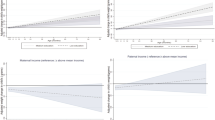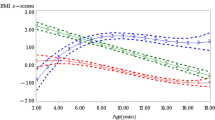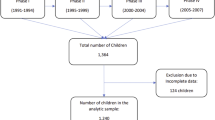Abstract
Background/objectives
Study sex- and ethnic-specific childhood BMI growth trajectories of US children, and explore the potential causes of ethnic disparities in childhood BMI trajectories, including household socio-economic status (SES) and parenting practice using nationally representative longitudinal data.
Subjects/methods
BMI trajectory curves between 7 months to 16 years of age were fitted using mixed effect models with fractional polynomial functions using pooled 10-year (1998–2008) longitudinal data collected from 29,254 children from two US nationally representative cohorts-Early Childhood Longitudinal Study-Birth (ECLS-B, 2001) and Kindergarten (ECLS-K, 1998–99). A multivariable regression model was used to examine the effects of SES and parenting factors on ethnic disparities in childhood BMI trajectory.
Results
Hispanic boys (HB) and African-American girls (AAG) continuously had the highest prevalence of overweight and obesity (HB: 52.5%, AAG: 49.1% around age of 11) and mean BMI after adiposity rebound than their counterparts. They had the earliest adiposity rebound (age mean [SD]: HB- 57.9 [7.8]; AAG- 59.0 [7.2] months), steeper BMI growth velocity (HB- 5.7 [1.8]; AAG- 7.0 [1.5] 10-2 kg/m2/month), and highest area under curve (HB- 2724.5 [489.8]; AAG- 2681.2 [426.7] kg/m2*month) from adiposity rebound to 16 years of age. The racial/ethnic disparities in childhood BMI trajectories were associated with household SES and family rules for children’s regular bedtime (p < 0.05).
Conclusions
In the US, ethnic disparities in childhood BMI trajectories and obesity are apparent starting from adiposity rebound around age of five. Some minority groups have unfavorable BMI trajectories. These disparities are partially explained by household SES and parenting factors.
This is a preview of subscription content, access via your institution
Access options
Subscribe to this journal
Receive 12 print issues and online access
$259.00 per year
only $21.58 per issue
Buy this article
- Purchase on Springer Link
- Instant access to full article PDF
Prices may be subject to local taxes which are calculated during checkout

Similar content being viewed by others
References
Lobstein T, Baur L, Uauy R. Obesity in children and young people: a crisis in public health. Obes Rev. 2004;5(Suppl 1):4–104.
Olshansky SJ, Passaro DJ, Hershow RC, Layden J, Carnes BA, Brody J, et al. A potential decline in life expectancy in the United States in the 21st century. New Engl J Med. 2005;352:1138–45.
Wang Y, Beydoun MA, Liang L, Caballero B, Kumanyika SK. Will all Americans become overweight or obese? estimating the progression and cost of the US obesity epidemic. Obes (Silver Spring). 2008;16:2323–30.
Wang Y, Lobstein T. Worldwide trends in childhood overweight and obesity. Int J Pediatr Obes. 2006;1:11–25.
Ng M, Fleming T, Robinson M, Thomson B, Graetz N, Margono C, et al. Global, regional, and national prevalence of overweight and obesity in children and adults during 1980-2013: a systematic analysis for the Global Burden of Disease Study 2013. Lancet. 2014;384:766–81.
Ogden CL, Carroll MD, Kit BK, Flegal KM. Prevalence of childhood and adult obesity in the United States, 2011-2012. JAMA. 2014;311:806–14.
Taveras EM, Gillman MW, Kleinman KP, Rich-Edwards JW, Rifas-Shiman SL. Reducing racial/ethnic disparities in childhood obesity: the role of early life risk factors. JAMA Pediatr. 2013;167:731–8.
Dixon B, Pena MM, Taveras EM. Lifecourse approach to racial/ethnic disparities in childhood obesity. Adv Nutr. 2012;3:73–82.
Parkes A, Sweeting H, Young R, Wight D. Does parenting help to explain socioeconomic inequalities in children’s body mass index trajectories? Longitudinal analysis using the Growing Up in Scotland study. J Epidemiol Community Health. 2016;70:868–73.
Balistreri KS, Van Hook J. Trajectories of overweight among US school children: a focus on social and economic characteristics. Matern Child Health J. 2011;15:610–9.
Morris TT, Northstone K, Howe LD. Examining the association between early life social adversity and BMI changes in childhood: a life course trajectory analysis. Pediatr Obes. 2016;11:306–12.
Guo SS, Huang C, Maynard LM, Demerath E, Towne B, Chumlea WC, et al. Body mass index during childhood, adolescence and young adulthood in relation to adult overweight and adiposity: the Fels Longitudinal Study. Int J Obes Relat Metab Disord. 2000;24:1628–35.
Siervogel RM, Roche AF, Guo SM, Mukherjee D, Chumlea WC. Patterns of change in weight/stature2 from 2 to 18 years: findings from long-term serial data for children in the Fels longitudinal growth study. Int J Obes. 1991;15:479–85.
Wen X, Kleinman K, Gillman MW, Rifas-Shiman SL, Taveras EM. Childhood body mass index trajectories: modeling, characterizing, pairwise correlations and socio-demographic predictors of trajectory characteristics. BMC Med Res Methodol. 2012;12:38.
Silverwood RJ, De Stavola BL, Cole TJ, Leon DA. BMI peak in infancy as a predictor for later BMI in the Uppsala Family Study. Int J Obes (Lond). 2009;33:929–37.
Chivers P, Hands B, Parker H, Beilin L, Kendall G, Bulsara M. Longitudinal modelling of body mass index from birth to 14 years. Obes Facts. 2009;2:302–10.
Tourangeau K, Nord C, Lê T, Sorongon AG, Najarian M. Early Childhood Longitudinal Study, kindergarten class of 1998–99 (ECLS-K), combined user’s manual for the ECLS-K eighth-grade and K–8 full sample data files and electronic codebooks (NCES 2009–004). Washington, DC: National Center for Education Statistics, Institute of Education Sciences, U.S. Department of Education; 2009.
The US CDC 2000 Growth Charts. Defining childhood obesity. [19 Jul 2016]. Available from: https://www.cdc.gov/obesity/childhood/defining.html.
Jensen SM, Ritz C, Ejlerskov KT, Molgaard C, Michaelsen KF. Infant BMI peak, breastfeeding, and body composition at age 3 y. Am J Clin Nutr. 2015;101:319–25.
Hof MH, Vrijkotte TG, de Hoog ML, van Eijsden M, Zwinderman AH. Association between infancy BMI peak and body composition and blood pressure at age 5-6 years. PLoS ONE. 2013;8:e80517.
Wang Y. Epidemiology of childhood obesity--methodological aspects and guidelines: what is new? Int J Obes Relat Metab Disord. 2004;28(Suppl 3):S21–8.
Rolland-Cachera MF, Deheeger M, Maillot M, Bellisle F. Early adiposity rebound: causes and consequences for obesity in children and adults. Int J Obes (Lond). 2006;30(Suppl 4):S11–17.
Baron RM, Kenny DA. The moderator-mediator variable distinction in social psychological research: conceptual, strategic, and statistical considerations. J Pers Soc Psychol. 1986;51:1173–82.
Guo SS, Wu W, Chumlea WC, Roche AF. Predicting overweight and obesity in adulthood from body mass index values in childhood and adolescence. Am J Clin Nutr. 2002;76:653–8.
Raitakari OT, Juonala M, Kahonen M, Taittonen L, Laitinen T, Maki-Torkko N, et al. Cardiovascular risk factors in childhood and carotid artery intima-media thickness in adulthood: the Cardiovascular Risk in Young Finns Study. JAMA. 2003;290:2277–83.
Janssen I, Katzmarzyk PT, Srinivasan SR, Chen W, Malina RM, Bouchard C, et al. Utility of childhood BMI in the prediction of adulthood disease: comparison of national and international references. Obes Res. 2005;13:1106–15.
Guerrero AD, Mao C, Fuller B, Bridges M, Franke T, Kuo AA. Racial and ethnic disparities in early childhood obesity: Growth trajectories in body mass index. J Racial Ethn Health Disparities. 2016;3:129–37.
Claire Wang Y, Gortmaker SL, Taveras EM. Trends and racial/ethnic disparities in severe obesity among US children and adolescents, 1976-2006. Int J Pediatr Obes: IJPO: Off J Int Assoc Study Obes. 2011;6:12–20.
Freedman DS, Khan LK, Serdula MK, Ogden CL, Dietz WH. Racial and ethnic differences in secular trends for childhood BMI, weight, and height. Obes (Silver Spring). 2006;14:301–8.
Ogden CL, Carroll MD, Curtin LR, Lamb MM, Flegal KM. Prevalence of high body mass index in US children and adolescents, 2007-2008. JAMA. 2010;303:242–9.
Wang Y, Chen X. How much of racial/ethnic disparities in dietary intakes, exercise, and weight status can be explained by nutrition- and health-related psychosocial factors and socioeconomic status among US adults? J Am Diet Assoc. 2011;111:1904–11.
Zilanawala A, Davis-Kean P, Nazroo J, Sacker A, Simonton S, Kelly Y. Race/ethnic disparities in early childhood BMI, obesity and overweight in the United Kingdom and United States. Int J Obes (Lond). 2015;39:520–9.
Centers for Disease CP. Obesity prevalence among low-income, preschool-aged children-United States, 1998-2008. MMWR Morb Mortal Wkly Rep. 2009;58:769–73.
Ji CY. Working Group on Obesity in C. Report on childhood obesity in China (1)--body mass index reference for screening overweight and obesity in Chinese school-age children. Biomed Environ Sci. 2005;18:390–400.
Cochrane SH, Leslie J, O’Hara DJ. Parental education and child health: intracountry evidence. Health Policy Educ. 1982;2:213–50.
Roberts JD, Rodkey L, Ray R, Knight B, Saelens BE. Electronic media time and sedentary behaviors in children: Findings from the Built Environment and Active Play Study in the Washington DC area. Prev Med Rep. 2017;6:149–56.
Centers for Disease Control and Prevention. Use of World Health Organization and CDC Growth Charts for children aged 0-59 months in the United States. MMWR Morb Mortal Wkly Rep. 2010;59(RR-9):1–13.
Acknowledgements
The present study is funded in part by a research grant from the US National Institutes of Health (NIH), the Eunice Kennedy Shriver National Institute of Child Health & Human Development (NICHD, 1R01HD064685-01A1).
Author information
Authors and Affiliations
Corresponding author
Ethics declarations
Conflict of interest
The authors declare that they have no conflict of interest.
Electronic supplementary material
Rights and permissions
About this article
Cite this article
Min, J., Wen, X., Xue, H. et al. Ethnic disparities in childhood BMI trajectories and obesity and potential causes among 29,250 US children: Findings from the Early Childhood Longitudinal Study-Birth and Kindergarten Cohorts. Int J Obes 42, 1661–1670 (2018). https://doi.org/10.1038/s41366-018-0091-4
Received:
Revised:
Accepted:
Published:
Issue Date:
DOI: https://doi.org/10.1038/s41366-018-0091-4
This article is cited by
-
Body Mass Index Trajectories among the Healthy Communities Study Children: Racial/Ethnic and Socioeconomic Disparities in Childhood Obesity
Journal of Racial and Ethnic Health Disparities (2024)
-
BMI Growth Profiles Among Black Children from Immigrant and US-Born Families
Journal of Immigrant and Minority Health (2024)
-
Racial and Ethnic Disparities in Childhood Growth Trajectories
Journal of Racial and Ethnic Health Disparities (2022)
-
Adherence to index-based dietary patterns in childhood and BMI trajectory during the transition to adolescence: the EPOCH study
International Journal of Obesity (2021)
-
Longitudinal trajectories of adiposity-related measures from age 2–5 years in a population of low-income Hispanic children
Pediatric Research (2021)



